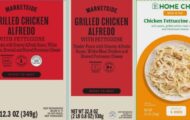The Center for Science in the Public Interest (CSPI) has released a white paper discussing antibiotic-resistant bacteria outbreaks in 2011. That year, 167 people were sickened and 47 were hospitalized.
There were three major outbreaks of antibiotic-resistant foodborne illness in 2011.
- In spring 2011, an outbreak of Salmonella Hadar associated with Jennie-O turkey burgers sickened 12 people in 10 states. The outbreak strain was resistant to ampicillin, amoxicillin/clavulanate, cephalothin, and tetracycline.
- In April 2011, 136 people in 34 states were sickened by Cargill ground turkey contaminated with Salmonella Heidelberg. The bacteria in that outbreak was resistant to ampicillin, streptomycin, tetracycline, and gentamicin.
- In December 2011, an outbreak of Salmonella Typhimurium in ground beef from Hannaford Supermarkets sickened 20 people in seven states.
Food Poisoning Bulletin has reported on how bacteria develop resistance to antibiotics when farm animals are routinely treated with subclinical doses of medication. The CSPI report reinforces that theory.
 The CSPI says that “outbreaks caused by antibiotic-resistant bacteria are not an emerging problem, but an established problem that needs more routine scrutiny by public health officials.” The white paper states that “cataloging foodborne illness outbreaks is a critical step in documenting the link between administering antibiotics to farm animals and human illness as it relates to antibiotic resistance.”
The CSPI says that “outbreaks caused by antibiotic-resistant bacteria are not an emerging problem, but an established problem that needs more routine scrutiny by public health officials.” The white paper states that “cataloging foodborne illness outbreaks is a critical step in documenting the link between administering antibiotics to farm animals and human illness as it relates to antibiotic resistance.”
One of the important points in the paper is the “off-label” use of antibiotics on farms. Farmers in the United States can use some antibiotics in their animals without a prescription and give them without veterinary oversight.
In 2008, drug manufacturers were required to report the drugs they sold for use in food-producing animals. In 2009 and 2010, there were 29 million pounds of active ingredient given to food-producing animals. Using those numbers, the CSPI calculated that food animals are given 80% of all antibiotics used in this country. And more than 60% of those antibiotics are identical or similar to those used to treat human beings.
CSPI collected information through literature and found 38 foodborne outbreaks between 1973 and 2011 where the bacteria responsible was resistant to at least one antibiotic. Of those, 17 occurred between 2000 and 2011. More than 20,000 people were sickened in these outbreaks; 3108 were hospitalized and 27 died.
Salmonella Typhimurium caused most of those illnesses, followed by Salmonella Newport and Salmonella Heidelberg. Enterotoxigenic E. coli caused five outbreaks, and Campylobacter jejuni and Staphylococcus aureus were responsible for one outbreak apiece.
Antibiotic-resistant patterns were established in 34 of those 38 outbreaks. The bacteria that caused the outbreaks were resistant to 15 different antibiotics, nine of which are classified by the World Health Organization (WHO) as “critically important” to human medicine.




